国际经济学作业答案-第十章
- 格式:doc
- 大小:780.00 KB
- 文档页数:12
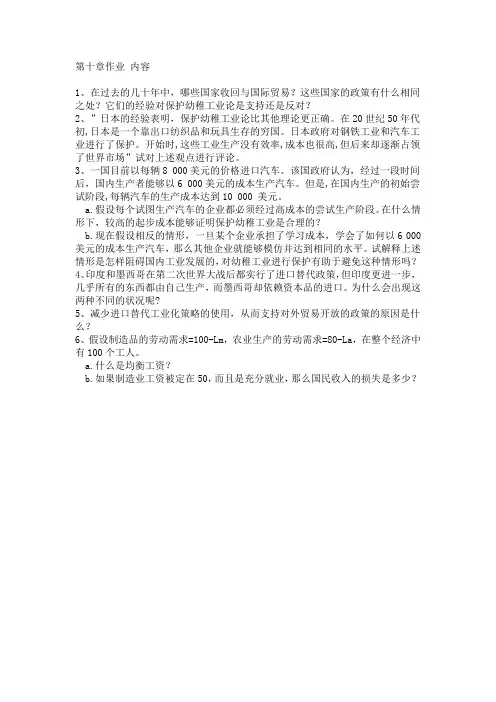
第十章作业内容
1、在过去的几十年中,哪些国家收回与国际贸易?这些国家的政策有什么相同之处?它们的经验对保护幼稚工业论是支持还是反对?
2、”日本的经验表明,保护幼稚工业论比其他理论更正确。
在20世纪50年代初,日本是一个靠出口纺织品和玩具生存的穷国。
日本政府对钢铁工业和汽车工业进行了保护。
开始时,这些工业生产没有效率,成本也很高,但后来却逐渐占领了世界市场”试对上述观点进行评论。
3、一国目前以每辆8 000美元的价格进口汽车。
该国政府认为,经过一段时间后,国内生产者能够以6 000美元的成本生产汽车。
但是,在国内生产的初始尝试阶段,每辆汽车的生产成本达到10 000 美元。
a.假设每个试图生产汽车的企业都必须经过高成本的尝试生产阶段。
在什么情形下,较高的起步成本能够证明保护幼稚工业是合理的?
b.现在假设相反的情形,一旦某个企业承担了学习成本,学会了如何以6 000美元的成本生产汽车,那么其他企业就能够模仿并达到相同的水平。
试解释上述情形是怎样阻碍国内工业发展的,对幼稚工业进行保护有助于避免这种情形吗?
4、印度和墨西哥在第二次世界大战后都实行了进口替代政策,但印度更进一步,几乎所有的东西都由自己生产,而墨西哥却依赖资本品的进口。
为什么会出现这两种不同的状况呢?
5、减少进口替代工业化策略的使用,从而支持对外贸易开放的政策的原因是什么?
6、假设制造品的劳动需求=100-Lm,农业生产的劳动需求=80-La,在整个经济中有100个工人。
a.什么是均衡工资?
b.如果制造业工资被定在50,而且是充分就业,那么国民收入的损失是多少?。
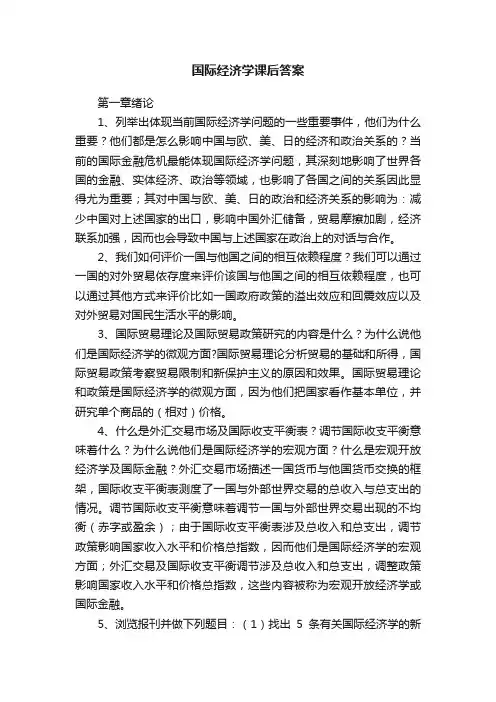
国际经济学课后答案第一章绪论1、列举出体现当前国际经济学问题的一些重要事件,他们为什么重要?他们都是怎么影响中国与欧、美、日的经济和政治关系的?当前的国际金融危机最能体现国际经济学问题,其深刻地影响了世界各国的金融、实体经济、政治等领域,也影响了各国之间的关系因此显得尤为重要;其对中国与欧、美、日的政治和经济关系的影响为:减少中国对上述国家的出口,影响中国外汇储备,贸易摩擦加剧,经济联系加强,因而也会导致中国与上述国家在政治上的对话与合作。
2、我们如何评价一国与他国之间的相互依赖程度?我们可以通过一国的对外贸易依存度来评价该国与他国之间的相互依赖程度,也可以通过其他方式来评价比如一国政府政策的溢出效应和回震效应以及对外贸易对国民生活水平的影响。
3、国际贸易理论及国际贸易政策研究的内容是什么?为什么说他们是国际经济学的微观方面?国际贸易理论分析贸易的基础和所得,国际贸易政策考察贸易限制和新保护主义的原因和效果。
国际贸易理论和政策是国际经济学的微观方面,因为他们把国家看作基本单位,并研究单个商品的(相对)价格。
4、什么是外汇交易市场及国际收支平衡表?调节国际收支平衡意味着什么?为什么说他们是国际经济学的宏观方面?什么是宏观开放经济学及国际金融?外汇交易市场描述一国货币与他国货币交换的框架,国际收支平衡表测度了一国与外部世界交易的总收入与总支出的情况。
调节国际收支平衡意味着调节一国与外部世界交易出现的不均衡(赤字或盈余);由于国际收支平衡表涉及总收入和总支出,调节政策影响国家收入水平和价格总指数,因而他们是国际经济学的宏观方面;外汇交易及国际收支平衡调节涉及总收入和总支出,调整政策影响国家收入水平和价格总指数,这些内容被称为宏观开放经济学或国际金融。
5、浏览报刊并做下列题目:(1)找出5条有关国际经济学的新闻(2)每条新闻对中国经济的重要性或影响(3)每条新闻对你个人有何影响A (1) 国际金融危机: 影响中国整体经济,降低出口、增加失业、经济减速等(2) 美国大选:影响中美未来经济政治关系(3) 石油价格持续下跌:影响中国的能源价格及相关产业(4) 可口可乐收购汇源被商务部否决:《反垄断法》的第一次实施,加强经济法治(5) 各国政府经济刺激方案:对中国经济产生外部性效应B 以上5条新闻对个人影响为:影响个人消费水平和就业前景第二章比较优势理论1、重商主义者的贸易观点如何?他们的国家财富概念与现在有何不同?重商主义者主张政府应当竭尽所能孤立出口,不主张甚至限制商品(尤其是奢侈类消费品)。
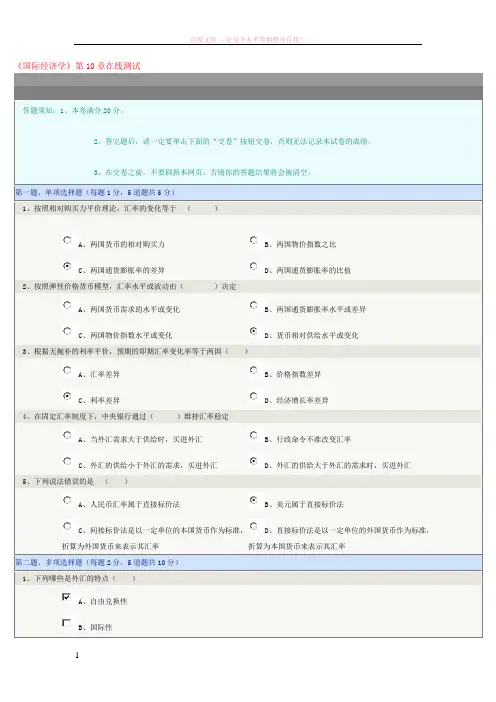
《国际经济学》第10章在线测试答题须知:1、本卷满分20分。
2、答完题后,请一定要单击下面的“交卷”按钮交卷,否则无法记录本试卷的成绩。
3、在交卷之前,不要刷新本网页,否则你的答题结果将会被清空。
第一题、单项选择题(每题1分,5道题共5分)1、按照相对购买力平价理论,汇率的变化等于 ( )A 、两国货币的相对购买力B 、两国物价指数之比C 、两国通货膨胀率的差异D 、两国通货膨胀率的比值2、按照弹性价格货币模型,汇率水平或波动由( )决定A 、两国货币需求的水平或变化B 、两国通货膨胀率水平或差异C 、两国物价指数水平或变化D 、货币相对供给水平或变化3、根据无抛补的利率平价,预期的即期汇率变化率等于两国( )A 、汇率差异B 、价格指数差异C 、利率差异D 、经济增长率差异4、在固定汇率制度下,中央银行通过( )维持汇率稳定A 、当外汇需求大于供给时,买进外汇B 、行政命令不准改变汇率C 、外汇的供给小于外汇的需求,买进外汇D 、外汇的供给大于外汇的需求时,买进外汇5、下列说法错误的是 ( )A 、人民币汇率属于直接标价法B 、美元属于直接标价法C 、间接标价法是以一定单位的本国货币作为标准,折算为外国货币来表示其汇率D 、直接标价法是以一定单位的外国货币作为标准,折算为本国货币来表示其汇率第二题、多项选择题(每题2分,5道题共10分) 1、下列哪些是外汇的特点( )A 、自由兑换性B 、国际性C、非国内性D、可偿性E、普遍接受性2、按照外汇可兑换限制程度的不同,外汇可以划分为( )A、自由兑换外汇B、有限制兑换外汇C、不可兑换外汇D、非贸易外汇E、即期外汇3、汇率的标价方式包括A、固定汇率B、浮动汇率C、直接标价法D、间接标价法E、套算汇率4、关于固定汇率制度的说法,正确的包括()A、较少的不稳定投机B、较低程度的不确定性C、容易造成汇率制度僵化D、容易促进输入性通货膨胀E、规范政府的宏观经济行为5、关于浮动汇率制度,下列说法正确的包括()A、较高的市场效率B、自动调节外部均衡C、货币政策失效D、不利于国际贸易和国际投资E、容易造成竞争性贬值第三题、判断题(每题1分,5道题共5分)1、按照相对购买力平价理论,通货膨胀率高的国家货币贬值。
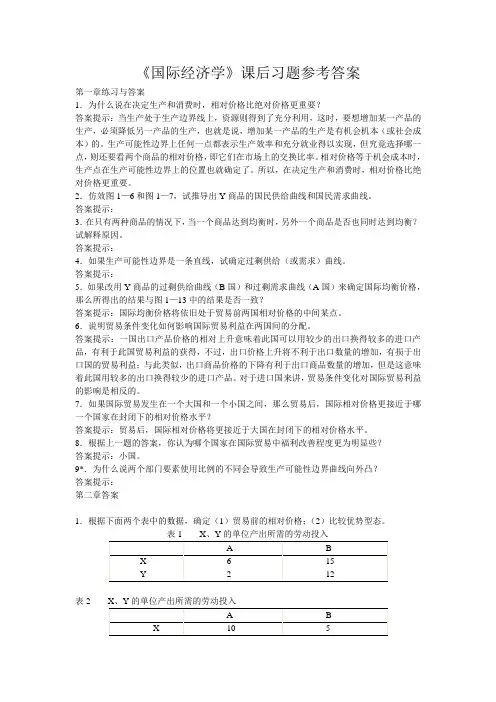
《国际经济学》课后习题参考答案第一章练习与答案1.为什么说在决定生产和消费时,相对价格比绝对价格更重要?答案提示:当生产处于生产边界线上,资源则得到了充分利用,这时,要想增加某一产品的生产,必须降低另一产品的生产,也就是说,增加某一产品的生产是有机会机本(或社会成本)的。
生产可能性边界上任何一点都表示生产效率和充分就业得以实现,但究竟选择哪一点,则还要看两个商品的相对价格,即它们在市场上的交换比率。
相对价格等于机会成本时,生产点在生产可能性边界上的位置也就确定了。
所以,在决定生产和消费时,相对价格比绝对价格更重要。
2.仿效图1—6和图1—7,试推导出Y商品的国民供给曲线和国民需求曲线。
答案提示:3.在只有两种商品的情况下,当一个商品达到均衡时,另外一个商品是否也同时达到均衡?试解释原因。
答案提示:4.如果生产可能性边界是一条直线,试确定过剩供给(或需求)曲线。
答案提示:5.如果改用Y商品的过剩供给曲线(B国)和过剩需求曲线(A国)来确定国际均衡价格,那么所得出的结果与图1—13中的结果是否一致?答案提示:国际均衡价格将依旧处于贸易前两国相对价格的中间某点。
6.说明贸易条件变化如何影响国际贸易利益在两国间的分配。
答案提示:一国出口产品价格的相对上升意味着此国可以用较少的出口换得较多的进口产品,有利于此国贸易利益的获得,不过,出口价格上升将不利于出口数量的增加,有损于出口国的贸易利益;与此类似,出口商品价格的下降有利于出口商品数量的增加,但是这意味着此国用较多的出口换得较少的进口产品。
对于进口国来讲,贸易条件变化对国际贸易利益的影响是相反的。
7.如果国际贸易发生在一个大国和一个小国之间,那么贸易后,国际相对价格更接近于哪一个国家在封闭下的相对价格水平?答案提示:贸易后,国际相对价格将更接近于大国在封闭下的相对价格水平。
8.根据上一题的答案,你认为哪个国家在国际贸易中福利改善程度更为明显些?答案提示:小国。
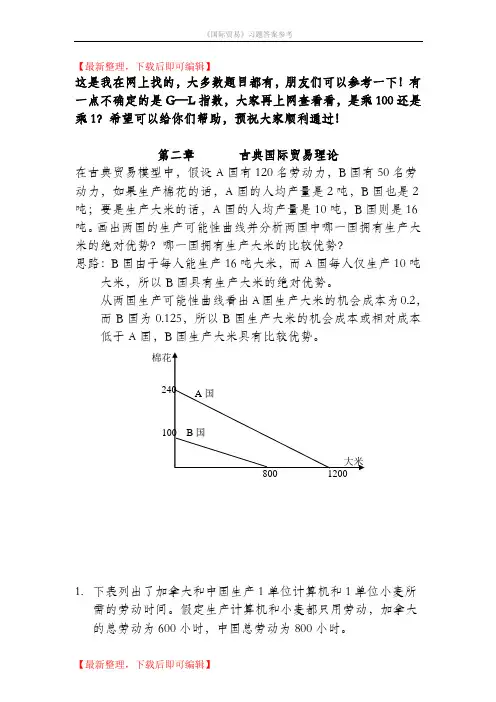
【最新整理,下载后即可编辑】这是我在网上找的,大多数题目都有,朋友们可以参考一下!有一点不确定的是G—L指数,大家再上网查看看,是乘100还是乘1?希望可以给你们帮助,预祝大家顺利通过!第二章古典国际贸易理论在古典贸易模型中,假设A国有120名劳动力,B国有50名劳动力,如果生产棉花的话,A国的人均产量是2吨,B国也是2吨;要是生产大米的话,A国的人均产量是10吨,B国则是16吨。
画出两国的生产可能性曲线并分析两国中哪一国拥有生产大米的绝对优势?哪一国拥有生产大米的比较优势?思路:B国由于每人能生产16吨大米,而A国每人仅生产10吨大米,所以B国具有生产大米的绝对优势。
从两国生产可能性曲线看出A国生产大米的机会成本为0.2,而B国为0.125,所以B国生产大米的机会成本或相对成本低于A国,B国生产大米具有比较优势。
1.下表列出了加拿大和中国生产1单位计算机和1单位小麦所需的劳动时间。
假定生产计算机和小麦都只用劳动,加拿大的总劳动为600小时,中国总劳动为800小时。
(1)计算不发生贸易时各国生产计算机的机会成本。
(2)哪个国家具有生产计算机的比较优势?哪个国家具有生产小麦的比较优势?(3)如果给定世界价格是1单位计算机交换22单位的小麦,加拿大参与贸易可以从每单位的进口中节省多少劳动时间?中国可以从每单位进口中节省多少劳动时间?如果给定世界价格是1单位计算机交换24单位的小麦,加拿大和中国分别可以从进口每单位的货物中节省多少劳动时间?(4)在自由贸易的情况下,各国应生产什么产品,数量是多少?整个世界的福利水平是提高还是降低了?试用图分析。
(以效用水平来衡量福利水平)思路:(1)中国生产计算机的机会成本为100/4=25,加拿大为60/3=20(2)因为加拿大生产计算机的机会成本比中国低,所以加拿大具有生产者计算机的比较优势,中国就具有生产小麦的比较优势。
(3)如果各国按照比较优势生产和出口,加拿大进口小麦出口计算机,中国进口计算机出口小麦。
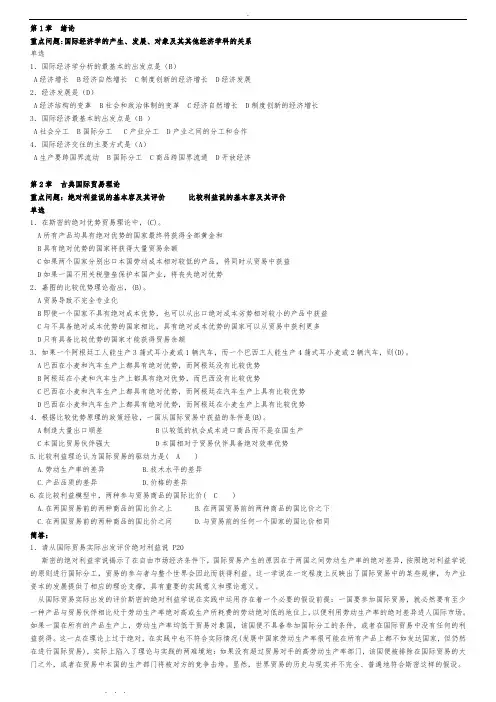
第1章绪论重点问题:国际经济学的产生、发展、对象及其其他经济学科的关系单选1.国际经济学分析的最基本的出发点是(B)A经济增长 B经济自然增长 C制度创新的经济增长 D经济发展2.经济发展是(D)A经济结构的变革 B社会和政治体制的变革 C经济自然增长 D制度创新的经济增长3.国际经济最基本的出发点是(B )A社会分工 B国际分工 C产业分工 D产业之间的分工和合作4.国际经济交往的主要方式是(A)A生产要跨国界流动 B国际分工 C商品跨国界流通 D开放经济第2章古典国际贸易理论重点问题:绝对利益说的基本容及其评价比较利益说的基本容及其评价单选1.在斯密的绝对优势贸易理论中,(C)。
A所有产品均具有绝对优势的国家最终将获得全部黄金和B具有绝对优势的国家将获得大量贸易余额C如果两个国家分别出口本国劳动成本相对较低的产品,将同时从贸易中获益D如果一国不用关税壁垒保护本国产业,将丧失绝对优势2.嘉图的比较优势理论指出,(B)。
A贸易导致不完全专业化B即使一个国家不具有绝对成本优势,也可以从出口绝对成本劣势相对较小的产品中获益C与不具备绝对成本优势的国家相比,具有绝对成本优势的国家可以从贸易中获利更多D只有具备比较优势的国家才能获得贸易余额3.如果一个阿根廷工人能生产3蒲式耳小麦或1辆汽车,而一个巴西工人能生产4蒲式耳小麦或2辆汽车,则(D)。
A巴西在小麦和汽车生产上都具有绝对优势,而阿根廷没有比较优势B阿根廷在小麦和汽车生产上都具有绝对优势,而巴西没有比较优势C巴西在小麦和汽车生产上都具有绝对优势,而阿根廷在汽车生产上具有比较优势D巴西在小麦和汽车生产上都具有绝对优势,而阿根廷在小麦生产上具有比较优势4.根据比较优势原理的政策经验,一国从国际贸易中获益的条件是(B)。
A制造大量出口顺差 B以较低的机会成本进口商品而不是在国生产C本国比贸易伙伴强大 D本国相对于贸易伙伴具备绝对效率优势5.比较利益理论认为国际贸易的驱动力是( A )A.劳动生产率的差异B.技术水平的差异C.产品品质的差异D.价格的差异6.在比较利益模型中,两种参与贸易商品的国际比价( C )A.在两国贸易前的两种商品的国比价之上B.在两国贸易前的两种商品的国比价之下C.在两国贸易前的两种商品的国比价之间D.与贸易前的任何一个国家的国比价相同简答:1.请从国际贸易实际出发评价绝对利益说 P20斯密的绝对利益学说揭示了在自由市场经济条件下,国际贸易产生的原因在于两国之间劳动生产率的绝对差异,按照绝对利益学说的原则进行国际分工,贸易的参与者与整个世界会因此而获得利益。
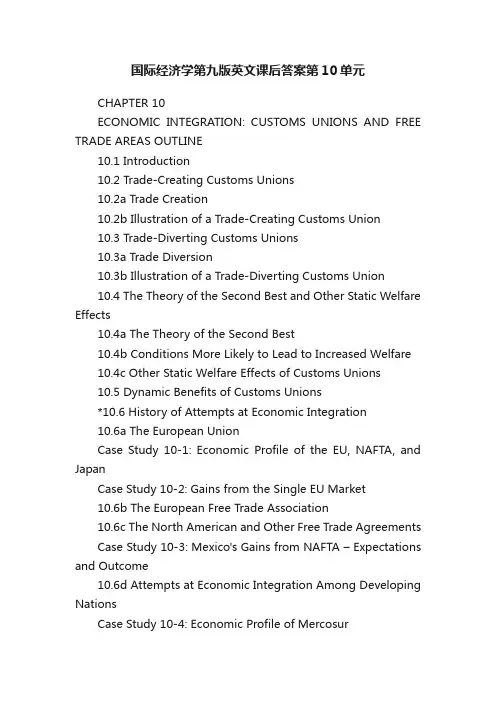
国际经济学第九版英文课后答案第10单元CHAPTER 10ECONOMIC INTEGRATION: CUSTOMS UNIONS AND FREE TRADE AREAS OUTLINE10.1 Introduction10.2 Trade-Creating Customs Unions10.2a Trade Creation10.2b Illustration of a Trade-Creating Customs Union10.3 Trade-Diverting Customs Unions10.3a Trade Diversion10.3b Illustration of a Trade-Diverting Customs Union10.4 The Theory of the Second Best and Other Static Welfare Effects10.4a The Theory of the Second Best10.4b Conditions More Likely to Lead to Increased Welfare10.4c Other Static Welfare Effects of Customs Unions10.5 Dynamic Benefits of Customs Unions*10.6 History of Attempts at Economic Integration10.6a The European UnionCase Study 10-1: Economic Profile of the EU, NAFTA, and JapanCase Study 10-2: Gains from the Single EU Market10.6b The European Free Trade Association10.6c The North American and Other Free Trade AgreementsCase Study 10-3: Mexico's Gains from NAFTA – Expectations and Outcome10.6d Attempts at Economic Integration Among Developing NationsCase Study 10-4: Economic Profile of MercosurCase Study 10-5: Changes in Trade Patterns with Economic Integration 344A10.6e Economic Integration in Central, Eastern Europe & Former Soviet RepublicsCase Study 10-6: Per Capita Income of Transition Economies Appendix: A10.1 General Equilibrium Analysis of Static Effects of a Trade-Diverting Customs UnionA10.2 Regional Trade Agreements Around the WorldKey TermsEconomic integration Variable import leviesPreferential trade arrangements European Free Trade Association (EFTA) (6920811.d oc) 10-1 Dominick Salvatore Free-trade area Trade deflectionCustoms union North American Free Trade Agreement (NAFTA) Common market Southern Common Market (Mercosur) Economic union Council of Mutual Economic Assistance (CMEA) Duty-free zones State trading companiesTrade creation Bilateral agreementsTrade diversion Bulk purchasingTrade-diverting customs union Central and Eastern European Countries (CEEC) Theory of the second best New Independent States (NIS)Tariff factories Commonwealth of Independent States (CIS) European Union (EU) Central European Free Trade Association (CEFTA)Baltic States Free Trade Area (BAFTA)Lecture Guide:1. This is not a core chapter and I would skip it except for section 6. Section 6 is animportant section and can be regarded as an extension ofChapter 9, which is a corechapter. Section 6 deals with a very important set of current events.2. Section 6 is a long section and may require two classes to be adequately presented. Iwould cover subsections a-d in one class and subsection e as well as both case studies in the second class. Case Studies 10-1 to 10-6 can be used for a very stimulating classdiscussion.3. While section 6 can be presented without covering the material in sections 1-5, someterms discussed in sections 1-5 (such as trade creation and trade diversion) need to bedefined.4. In a one-year course in international economics, I would cover the entire chapter. I wouldthen cover sections 10-1 to 10-3 in one class and sections 10-4 and 10-5 in the secondclass. In the first class, the most important aspect would be the presentation and clearexplanation of Figures 10-1 and 10-2.Answers to Problems:1. If Nation A imposes a 100 percent ad valorem tariff on imports of commodity X fromNation B and Nation C, Nation A will produce commodity X domestically because thedomestic price of commodity X is $10 as compared with the tariff-inclusive price of$16 if Nation A imported commodity X from Nation B and $12 if Nation A importedcommodity X from nation C.2. a) If Nation A forms a customs union with Nation B, NationA will import commodity (6920811.d oc) 10-2 Dominick SalvatoreX from Nation B at the price of $8 instead of producing it itself at $10 or importing itfrom Nation C at the tariff-inclusive price of $12.b) When Nation A forms a customs union with Nation B this would be a trade-creatingcustoms union because it replaces domestic production of commodity X at Px=$10with tariff-free imports of commodity X from Nation B at Px=$8.3. If Nation A imposes a 50 percent ad valorem tariff on imports of commodity X fromNation B and Nation C, Nation A will import commodity X from nation C at the tariff- inclusive price of $9 instead of producing commodity X itself or importing it fromNation B at the tariff-inclusive price of $12.4. a) If Nation A forms a customs union with Nation B, NationA will import commodityX from Nation B at the price of $8 instead of importing it from Nation C at the tariff-inclusive price of $9.b) When Nation A forms a customs union with Nation B this would be a trade-divertingcustoms union because it replaces lower-price imports of commodity X of $6 (fromthe point of view of Nation A as a whole) with higher priced imports of commodityX from Nation B at $8.Specifically, Nation A's importers do not import commodity X from Nation Cbecause the tariff-inclusive price of commodity X from Nation C is $9 as comparedwith the no-tariff price of $8 for imports of commodity X from Nation B. However,since the government of Nation A collects the $3 tariff per unit on imports ofcommodity X from Nation C, the net effective price for imports of commodity Xfrom Nation C is really $6 for Nation A as a whole.5. See Figure 10-1 in the text. Any figure similar to Figure 10-1 in the text would do.6. The welfare gains that Nation 2 receives from joining Nation 1 to form a customs unionis given by the sum of the areas of triangles CJM and BHN in Figure 10-1 in the text.Any similar figure and sum of corresponding triangles would, of course, be adequate.7. See Figure 10-2 in the text. Any figure similar to Figure 10-2 in the text would do.8. The welfare loss that Nation 2 receives from joining Nation 1 to form a customs unionis given by C'JJ'+B'HH'- MNH'J'=$11.25 in Figure 10-2 in the text.Any similar figure and sum of corresponding triangles minus the area of corresponding rectangle would, of course, be adequate.9. See Figure 1 and compare it to Figure 10-2.10. The net gain from the trade-diverting customs unionshown in Figure 1 is given byC'JJ'+B'HH'-MJ'H'N. As contrasted with the case in Figure 10-2, however, the sum (6920811.d oc) 10-3 Dominick Salvatore of the areas of the two triangles (measuring gains) is greater than the area the rectangle (measuring the loss). Thus, the nation would now gain from the formation of a custom union. Had we drawn the figure on graph paper, we would have been able to measure the net gain in monetary terms also.11. A trade-diverting customs union is more likely to lead toa welfare gain of a membernation (1) the smaller is the relative inefficiency of nation 3 with respect to nation 1,(2) the higher is the level of the tariff, and (3) the more elastic are Dx and Sx in nation2. These can seen by comparing Figure 10-2 in the text with Figure 1 on the next page.12. See Figure 2. The formation of the customs union has no effect.13. NAFTA created much more controversy because the very low wages in Mexico led togreat fears of large job losses in the U. S.14. The possible cost to the U.S. from EU92 arose from the increased efficiency andcompetitiveness of the E.U. The benefit arose because a more rapid growth in the EU spills into a greater demand for American products, which benefits the U. S.App. Compare points B' and H' in Figure 10-3 with the corresponding points inFigure 3.Multiple-choice Questions:1. Which of the following statements is correct?*a. In a customs union, member nations apply a uniform external tariffb. in a free-trade area, member nations harmonize their monetary and fiscal policiesc. within a customs union there is unrestricted factor movementd. a customs union is a higher form of economic integration than a common market2. A customs union that allows for the free movement of labor and capital among its member nations is called a:a. preferential trade arrangementb. free-trade area*c. common marketd. all of the above3. A trade-creating customs union is one where:a. lower-cost imports from outside the customs union are replaced by higher-cost imports from a union member *b. some domestic production in a member nation is replaced by lower-cost imports from another member nationc. trade among members increases but trade with nonmembers decreasesd. trade among members decreases while trade with nonmembers increases4. A trade-diverting customs union:a. increases trade among union members and with nonmember nationsb. reduces trade among union members and with nonmember nations*c. increases trade among members but reduces trade with non-membersd. reduces trade among union members but increases it with nonmembers5. A trade-diverting customs union results in:a. trade diversion onlyb. trade creation only*c. both trade creation and trade diversiond. we cannot say6. The formation of a trade-creating customs union where all economic resources of membernations are fully employed before and after the formation of the customs union leads to an:*a. increase in the welfare of member and nonmember nationsb. increase in the welfare of member nations onlyc. increase in the welfare of nonmember nations onlyd. increase or decrease in the welfare of member and nonmember nations7. A trade-diverting customs union:a. increases the welfare of member and nonmember nationsb. reduces the welfare of member and nonmember nationsc. increases the welfare of member nations but reduces that of nonmembers*d. reduces the welfare of nonmembers and may increase or reduce that of members8. A trade-diverting customs union is more likely to lead to trade creation:a. the lower are the pre-union trade barriers of the member countries*b. the lower are the customs union's barriers on trade with the rest of the worldc. the smaller is the number of countries forming the customs union and the smaller their sized. the more complementary rather than competitive are the economies of the nations forming the customs union9. The theory of customs union is a special case of the theory of:a. effective protection*b. the second bestc. the product cycled. comparative advantage10. Which is not a dynamic benefit from the formation of a customs union?a. increased competitionb. economies of scalec. stimulus to investment*d. trade creation11. The formation of the EU resulted in:a. trade creation in industrial and agricultural productsb. trade diversion in industrial and agricultural products*c. trade creation in industrial products and trade diversion in agricultural productsd. trade diversion in industrial products and trade creation in agricultural products12. The benefit that the United States is likely to receive from NAFTA:*a. increasing competition in product and resource marketsb. greater technical innovationc. improvements in its terms of traded. all of the above13. The benefit that Mexico is likely to receive from NAFTA:a. greater export-led growthb. encouraging the return of flight capitalc. more rapid structural change*d. all of the above14. Which is a stumbling block to successful economic integration among groups ofdeveloping nations?a. benefits are not evenly distributed among nationsb. many developing nations are not willing to relinquish part of their newly-acquired sovereignty to a supranational community body, as required for successful economic integrationc. the complementary nature of their economies and competition for the same world markets for their agricultural exports*d. all of the above15. The formation of a free trade area among the countries of Eastern Europe is advocatedin order to:a. restore trade trading*b. retain the traditional trade links that can be justified on market principlesc. reduce the need for structural changed. none of the above。
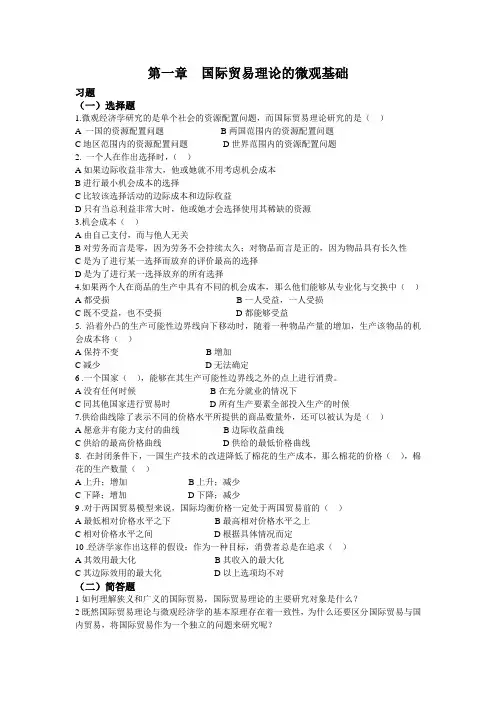
第一章国际贸易理论的微观基础习题(一)选择题1.微观经济学研究的是单个社会的资源配置问题,而国际贸易理论研究的是()A 一国的资源配置问题B两国范围内的资源配置问题C地区范围内的资源配置问题D世界范围内的资源配置问题2. 一个人在作出选择时,()A如果边际收益非常大,他或她就不用考虑机会成本B进行最小机会成本的选择C比较该选择活动的边际成本和边际收益D只有当总利益非常大时,他或她才会选择使用其稀缺的资源3.机会成本()A由自己支付,而与他人无关B对劳务而言是零,因为劳务不会持续太久;对物品而言是正的,因为物品具有长久性C是为了进行某一选择而放弃的评价最高的选择D是为了进行某一选择放弃的所有选择4.如果两个人在商品的生产中具有不同的机会成本,那么他们能够从专业化与交换中()A都受损B一人受益,一人受损C既不受益,也不受损D都能够受益5. 沿着外凸的生产可能性边界线向下移动时,随着一种物品产量的增加,生产该物品的机会成本将()A保持不变B增加C减少D无法确定6 .一个国家(),能够在其生产可能性边界线之外的点上进行消费。
A没有任何时候B在充分就业的情况下C同其他国家进行贸易时D所有生产要素全部投入生产的时候7.供给曲线除了表示不同的价格水平所提供的商品数量外,还可以被认为是()A愿意并有能力支付的曲线B边际收益曲线C供给的最高价格曲线D供给的最低价格曲线8. 在封闭条件下,一国生产技术的改进降低了棉花的生产成本,那么棉花的价格(),棉花的生产数量()A上升;增加B上升;减少C下降;增加D下降;减少9 .对于两国贸易模型来说,国际均衡价格一定处于两国贸易前的()A最低相对价格水平之下B最高相对价格水平之上C相对价格水平之间D根据具体情况而定10 .经济学家作出这样的假设:作为一种目标,消费者总是在追求()A其效用最大化B其收入的最大化C其边际效用的最大化D以上选项均不对(二)简答题1如何理解狭义和广义的国际贸易,国际贸易理论的主要研究对象是什么?2既然国际贸易理论与微观经济学的基本原理存在着一致性,为什么还要区分国际贸易与国内贸易,将国际贸易作为一个独立的问题来研究呢?3用相对价格概念解释经济行为主体是如何摆脱“货币幻觉”的影响的。

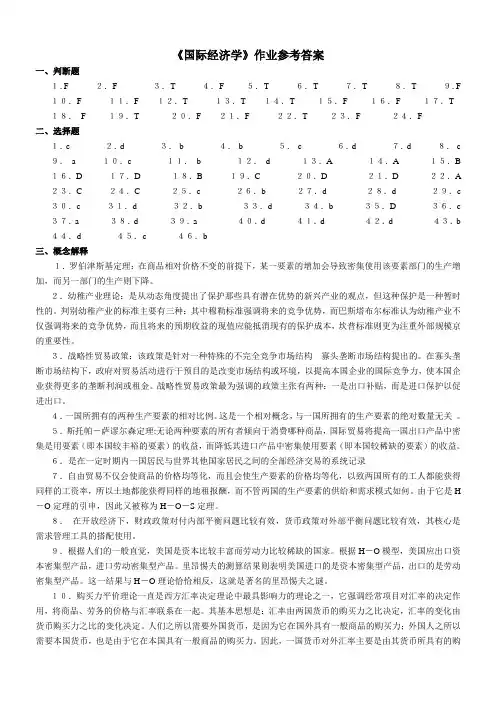
《国际经济学》作业参考答案一、判断题1.F2.F 3.T 4.F 5.T 6.T 7.T 8.T 9.F 10.F 11.F 12.T13.T 14.T 15.F 16.F 17.T 18.F 19.T 20.F 21.F 22.T23.F 24.F二、选择题1.c 2.d 3.b 4.b 5.c 6.d 7.d 8.c 9.a 10.c 11.b 12.d 13.A 14.A 15.B 16.D 17.D 18.B 19.C 20.D 21.D 22.A 23.C 24.C 25.c 26.b 27.d 28.d 29.c 30.c 31.d 32.b 33.d 34.b 35.D36.c 37.a 38.d 39.a 40.d 41.d 42.d 43.b 44.d 45.c 46.b三、概念解释1.罗伯津斯基定理:在商品相对价格不变的前提下,某一要素的增加会导致密集使用该要素部门的生产增加,而另一部门的生产则下降。
2.幼稚产业理论:是从动态角度提出了保护那些具有潜在优势的新兴产业的观点,但这种保护是一种暂时性的。
判别幼稚产业的标准主要有三种:其中穆勒标准强调将来的竞争优势,而巴斯塔布尔标准认为幼稚产业不仅强调将来的竞争优势,而且将来的预期收益的现值应能抵消现有的保护成本,坎普标准则更为注重外部规模京的重要性。
3.战略性贸易政策:该政策是针对一种特殊的不完全竞争市场结构---寡头垄断市场结构提出的。
在寡头垄断市场结构下,政府对贸易活动进行干预目的是改变市场结构或环境,以提高本国企业的国际竞争力,使本国企业获得更多的垄断利润或租金。
战略性贸易政策最为强调的政策主张有两种:一是出口补贴,而是进口保护以促进出口。
4.一国所拥有的两种生产要素的相对比例。
这是一个相对概念,与一国所拥有的生产要素的绝对数量无关。
5.斯托帕-萨谬尔森定理:无论两种要素的所有者倾向于消费哪种商品,国际贸易将提高一国出口产品中密集是用要素(即本国较丰裕的要素)的收益,而降低其进口产品中密集使用要素(即本国较稀缺的要素)的收益。
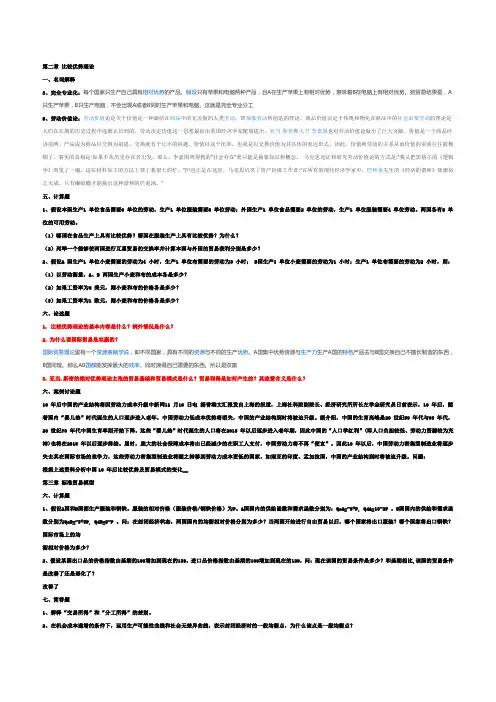
第二章比较优势理论一、名词解释3、完全专业化:每个国家只生产自己具有相对优势的产品。
假设只有苹果和电脑两种产品,且A在生产苹果上有相对优势,意味着B在电脑上有相对优势。
则贸易结果是,A 只生产苹果,B只生产电脑,不会出现A或者B同时生产苹果和电脑。
这就是完全专业分工5、劳动价值论:劳动价值论是关于价值是一种凝结在商品中的无差别的人类劳动,即抽象劳动所创造的理论。
商品价值决定于体现和物化在商品中的社会必要劳动的理论是人们在长期的历史过程中逐渐认识到的。
劳动决定价值这一思想最初由英国经济学家配第提出。
亚当·斯密和大卫·李嘉图也对劳动价值论做出了巨大贡献。
价值是一个商品经济范畴。
产品成为商品以交换为前提。
交换就有个比率的问题。
价值以这个比率,也就是以交换价值为其具体的表达形式,因此,价值和劳动的关系从而价值的实质往往被模糊了。
事实的真相是:如果不从历史存在者出发,那么,李嘉图所得到的"社会存在"就只能是抽象知识和概念。
马克思论证和研究劳动价值论的方式是:"我又把黑格尔的《逻辑学》浏览了一遍,这在材料加工的方法上帮了我很大的忙。
"但也正是在这里,马克思讥笑了资产阶级工作者:"在所有的现代经济学家中,巴师夏先生的《经济的谐和》集庸俗之大成。
只有癞蛤蟆才能搞出这种谐和的烂泥汤。
"五、计算题1、假设本国生产1 单位食品需要6 单位的劳动,生产1 单位服装需要8 单位劳动;外国生产1 单位食品需要2 单位的劳动,生产1 单位服装需要4 单位劳动。
两国各有8 单位的可用劳动。
(1)哪国在食品生产上具有比较优势?哪国在服装生产上具有比较优势?为什么?(2)列举一个能够使两国进行互惠贸易的交换率并计算本国与外国的贸易获利分别是多少?2、假设A 国生产1 单位小麦需要的劳动为4 小时,生产1 单位布需要的劳动为3 小时; B国生产1 单位小麦需要的劳动为1 小时;生产1 单位布需要的劳动为2 小时,则:(1)以劳动衡量,A、B 两国生产小麦和布的成本各是多少?(2)如果工资率为6 美元,则小麦和布的价格各是多少?(3)如果工资率为1 欧元,则小麦和布的价格各是多少?六、论述题1. 比较优势理论的基本内容是什么?例外情况是什么?2.为什么说国际贸易是双赢的?国际贸易理论里有一个资源禀赋学说,即不同国家,具有不同的资源与不同的生产优势。
克鲁格曼《国际经济学》中文版·第九版课后习题答案第一章练习与答案1.为什么说在决定生产和消费时,相对价格比绝对价格更重要?答案提示:当生产处于生产边界线上,资源则得到了充分利用,这时,要想增加某一产品的生产,必须降低另一产品的生产,也就是说,增加某一产品的生产是有机会机本(或社会成本)的。
生产可能性边界上任何一点都表示生产效率和充分就业得以实现,但究竟选择哪一点,则还要看两个商品的相对价格,即它们在市场上的交换比率。
相对价格等于机会成本时,生产点在生产可能性边界上的位置也就确定了。
所以,在决定生产和消费时,相对价格比绝对价格更重要。
2.仿效图1—6和图1—7,试推导出Y商品的国民供给曲线和国民需求曲线。
答案提示:3.在只有两种商品的情况下,当一个商品达到均衡时,另外一个商品是否也同时达到均衡?试解释原因。
答案提示:4.如果生产可能性边界是一条直线,试确定过剩供给(或需求)曲线。
答案提示:5.如果改用Y商品的过剩供给曲线(B国)和过剩需求曲线(A国)来确定国际均衡价格,那么所得出的结果与图1—13中的结果是否一致?答案提示:国际均衡价格将依旧处于贸易前两国相对价格的中间某点。
6.说明贸易条件变化如何影响国际贸易利益在两国间的分配。
答案提示:一国出口产品价格的相对上升意味着此国可以用较少的出口换得较多的进口产品,有利于此国贸易利益的获得,不过,出口价格上升将不利于出口数量的增加,有损于出口国的贸易利益;与此类似,出口商品价格的下降有利于出口商品数量的增加,但是这意味着此国用较多的出口换得较少的进口产品。
对于进口国来讲,贸易条件变化对国际贸易利益的影响是相反的。
7.如果国际贸易发生在一个大国和一个小国之间,那么贸易后,国际相对价格更接近于哪一个国家在封闭下的相对价格水平?答案提示:贸易后,国际相对价格将更接近于大国在封闭下的相对价格水平。
8.根据上一题的答案,你认为哪个国家在国际贸易中福利改善程度更为明显些?答案提示:小国。
国际经济学作业答案■第十章Chapter 10 Trade in Developing CountriesMultiple Choice Questions1.The infant industry argument was an important theoretical basis for(a)Neo-colonialist theory of international exploitation.(b)Import-substituting industrialization.(c)Historiography of the industrial revolution in Western Europe.(d)East-Asian miracle.(e)None of the above.Answer: B2.Sophisticated theoretical arguments supporting import-substitution policies include(a)Terms of trade effects.(b)Scale economy arguments.(c)Learning curve considerations.(d)The problem of appropriability.(e)None of the above.Answer: D3.General equilibrium considerations lead to the realization that import-substituting policies havean effect of(a)Discouraging exports.(b)Encouraging exports.(c)Encouraging an efficient use of a country ’ s resources.(d)Generating large tariff revenues for the government(e)None of the above.Answer: A4.Historically those few developing countries which have succeeded in significantly raising their per-capita income levels(a)Did not accomplish this with import-substituting industrialization.(b)Did accomplish this with import-substituting industrialization.(c)Tended to provide heavy protection to domestic industrial sectors.(d)Favored industrial to agricultural or service sectors.(e)None of the above.Answer: AChapter 10 Trade in Developing Countries 1085.Statistical evidence suggests that(a)Free trade policies promote economic growth more effectively than do import substitution policies.(b)Import substituting policies tend to promote effective exploitation of scale economies.(c)Import substitution tends to lead to relatively low effective rates of protection.(d)Import substitution is to this day the preferred growth strategy promoted by the World Bank.(e)None ofthe above.Answer: A6.The growth successes ofthe high performance Asian economies(a)Supports the belief that economic development requires import substitution policies.(b)Rejects the beliefthat export-oriented industrialization is likely to promote economicdevelopment.(c)Rejects the beliefthat economic development requires import substitution policies.(d)Suggests that free trade policies are required for successful economic development.(e)None ofthe above.Answer: C7.The high correlation between rapid growth in exports and rapid economic growth observed in several EastAsia countries in recent decades proves that(a)Export promoting trade policy leads to relatively rapid economic growth.(b) A free-trade orientation of trade policy results in rapid economic growth.(c)Exports help growth, whereas imports impede growth.(d)Trade policy is perhaps the most important policy area for promotion of economic development.(e)None ofthe above.Answer: E8.The relatively rapid economic growth experienced by Chile in the late 1980s(a)Supported the conventional Latin American reliance on import substitution.(b)Relied on the Harris-Todaro model to explain this growth.(c)Rejected the conventional Latin American reliance on import substitution.(d)Demonstrated the importance of market failure as a reason for import substitution.(e)None ofthe above.Answer: C9.Which ofthe following could explain why the terms of trade of developing countries might deteriorateover time?(a)Developing country exports consist mainly of manufactured goods(b)Developing country exports consist mainly of primary products.(c)Commodity export prices are determined in highly competitive markets.(d)Commodity export prices are solely determined by developing countries.(e)None ofthe above.Answer: C10.Which trade strategy have developing countries used to restrict imports of manufactured goods so thatthe domestic market is preserved for home producers, who thus can take over markets already established in the country?(a)International commodity agreement.(b)Export promotion.(c)Multilateral contract.(d)Import substitution.(e)None of the above.Answer: D11.To help developing countries expand their industrial base, some industrial countries have reducedtariffs on designated manufactured imports from developing countries below the levels applied toimports from industrial countries. This policy is called(a)Export-led growth.(b)Generalized system of preferences.(c)Most Favored Nation.(d)Reciprocal trade agreement.(e)None of the above.Answer: B12.Which industrialization policy used by developing countries places emphasis on the comparativeadvantage principle as a guide to resource allocation?(a)Export promotion.(b)Import substitution.(c)International commodity agreements.(d)Infant Industry promotion.(e)None of the above.Answer: A13.Taiwan and South Korea are examples of developing nations that have recently pursued theseindustrialization policies(a)Import substitution.(b)Export promotion.(c)Commercial dumping.(d)Multilateral contract.(e)None of the above.Answer: B14.To help developing nations strengthen their international competitiveness, many industrial nations havegranted tariff reductions to developing nations under the(a)International commodity agreements program.(b)Multilateral contract program.(c)Generalized system of preferences program.(d)Export led growth program(e)None of the above.Answer: C15. A reason why it is difficult for developing countries to maintain a cartel is that(a)The elasticity of demand for a cartel ' s output decreases over time.(b)Producers in the cartel have an economic incentive to cheat.(c)Economic profits discourage other producers from entering the industry.(d)Producers in the cartel have the motivation to lower prices but not to raise prices.(e)None of the above.Answer: B16.Import substitution policies make use of(a)Tariffs that discourage goods from entering a country.(b)Quotas applied to goods that are shipped abroad.(c)Production subsidies granted to industries with comparative advantage.(d)Tax breaks granted to industries with comparative advantage.(e)None of the above.Answer: A17.Export-led growth tends to(a)Discourage competition in the global economy.(b)Exploit domestic comparative advantages.(c)Lead to unemployment among domestic workers.(d)Help firms benefit from diseconomies of large-scale production.(e)None of the above.Answer: B18.All the following nations except have recently utilized export-led growth policies.(a)Hong Kong(b)South Korea(c)Argentina(d)Singapore(e)None of the above.Answer: C19.The development of countries like South Korea has been supported by all of the following except.(a)High domestic interest rates.(b)High domestic saving rates.(c)Large endowments of human capital.(d)High levels of labor productivity.(e)None of the above.Answer: A20.For most developing countries(a)Productivity is high among domestic workers.(b)Population growth and illiteracy rates are low(c)Saving and investment levels are high(d)Agricultural goods and raw materials constitute a high proportion of domestic output.(e)None ofthe above.Answer: D21.In 2003, the per-capita income in China was roughly of that in the U.S.(a)one hundredth(b)One eighth(c)One half(d)The same as(e)None ofthe above.Answer: B22.The "EastAsian Miracle ” is(a)The ability of so many people to live in such small areas.(b)The fact that so many Influenza varieties originate from this region.(c)The fact that poor dualistic economies managed to escape the vicious circle of poverty.(d)The ability to maintain large positive trade balances with the U.S.(e)None ofthe above.Answer: C23.The infant industry argument is that(a)Comparative advantage is irrelevant to economic growth(b)Developing countries have a comparative advantage in agricultural goods.(c)Developing countries have a comparative advantage in manufacturing.(d)Developing countries have a potential comparative advantage in manufacturing.(e)None ofthe above.Answer: D24.The infant industry argument calls for active government involvement(a)Only if the government forecasts are accurate.(b)Only if some market failure can be identified.(c)Only if the industry is not one already dominated by industrial countries.(d)Only if the industry has a high value added.(e)None ofthe above.Answer: B25.The imperfect capital market justification for infant industry promotion(a)Assumes that new industries will tend to have low profits.(b)Assumes that infant industries will soon mature.(c)Assumes that infant industries will be in products of comparative advantage.(d)Assumes that banks can allocate resources efficiently.(e)None ofthe above.Answer: A26.Brazil ' s export record in 1999 illustrated the principle that(a) A large country will tend to have few exports.(b) A small country will tend to have a high export ratio.(c)Protectionist policies tend to discourage exports.(d)Export-promoting policies do not tend to work.(e)None ofthe above.Answer: C27.The disappointment with import-substitution policies is in part because(a)The rapid and continuous growth record of South American countries.(b)Many countries pursuing this strategy experienced stagnation in their growth.(c)This policy is inconsistent with sophisticated economic growth models.(d)This policy tended to create world-class industrial competitors.(e)None ofthe above.Answer: B28.Import substitution policies have over time tended to involve all but the following(a)Overlapping import quotas.(b)Exchange controls.(c)Domestic content rules.(d)Simple tariffs.(e)Multiple exchange rate schemes.Answer: D29.An efficient economy would set the marginal product in the traditional sector(a)Lower than that in the modern non-traditional sector.(b)Higher than that in the modern sophisticated sector.(c)Equal to that in the modern sophisticated sector.(d)Lower in the relatively capital intensive sector.(e)Higher in the relatively capital intensive sector.Answer: C30.The HPAE (High Performance Asian Economies) countries(a)Have all consistently supported free trade policies.(b)Have all consistently maintained import-substitution policies.(c)Have all consistently maintained non-biased efficient free capital markets.(d)Have all maintained openness to international trade.(e)None ofthe above.Answer: D31.The experience of Sub- Sahara Africa, as compared to that of “ Other Aclading thnHPAEs) supports the argument that(a)High rates of protection tend to harm economic growth(b)The poorer is the country the easier it is for it to “ catch up “ economically(c)Low rates of protection tend to promote economic growth(d)Both (a) and (c)(e)None of the aboveAnswer: E32.The remarkable success of the HPAEs proves that(a)trade policy is the key to successful economic growth(b)trade policy is irrelevant to successful economic growth(c)high educational standards is the key to successful economic growth(d)dual economies must suffer economic stagnation(e)None of the aboveAnswer: E33.Th e HPAE “ economic miracle “ illustrates a clear case in which(a)exports and growth were positively related(b)exports were promoted by successful economic growth(c)economic growth was determined by successful export promotion(d)trade policy dominated other considerations in promoting economic growth(e)None of the aboveAnswer: A34.The "East Asian Miracle " of the " FonrtTige960s was replicated by(a)developing countries around the world(b)other East Asian countries(c)Sub Sahara African countries(d)Industrialized countries(e)None of the aboveAnswer: B35.The experience of Chile ' s foreign sector in the kastetw^des of the 20th Century supports the proposition that economicgrowth is supported by(a)Import substitution(b)Industrialization policies(c)Trade liberalization policies(d)Both (a) and (b) above(e)None of the aboveAnswer: C36.China ' s rent experience supports the proposition that(a)“ Economic miracles “ are solely to be expected in small countries(b)Central planning and socialism can promote sustained economic growth(c) A lessening of income disparities is a prerequisite for economic growth(d)Growth in a large country cannot be affected by its foreign sector(e)None of the aboveAnswer: EEssay Questions1.It is argued that import substitution is a misguided trade policy if the intent is to promote long-term economic growth.Explain the reasons underlying this argument.Answer: Import substitution promotes that economic activity in which the country is relatively inefficient. This lowers the real income at any given time and decreases the resources which can be used for investment purposes, hencelower growth rates. An additional answer is that import substitution by creating a protected domestic marketfails to provide incentives to produce high, or world-class quality —whichmeans this country, cannot market in foreign countries. With such a (perceived) limited market, endogenouseconomic growth will not be forthcoming. Finally, it may be that exposure to world competition has its owndynamic effect promoting economic growth.2.The United States, as it began its long and successful growth in the early 19th Century, consciously promoted domesticproduction through such activities as tariffs, Clay System, and many direct subsidies to railroads, canal companies, farmers (free land) etc. Today we view this blatant example of large scale and extensive import-substitution industrialization as having been very successful. Comment and relate to your answer to question 1.Answer: This is an interesting point and emphasizes that economic models tend to be a-historical. That is, they lack the historic perspective; and thus may be misleading as guides to long run issues, such as economic growth. Thisalso suggests that trade policy per se is almost certainly not sufficient to explain why some countries grow andothers do not.3.Classical and Neoclassical trade theory makes the case that free trade can bring a country to an optimum and economicallyefficient use of its resources; and hence is an optimal trade-policy, if the objective is maximizing long term economic growth. There are those who argue that the experience of the Asian Miracle countries, such as Taiwan, South Korea and Singapore verify this argument in the real world. Explain. There are others who argue that the experience of these countries cannot be used to verify or support the argument above. Explain.Answer: Both arguments may indeed be made. These countries did in fact tend to promote exports in a consistent set of policies. However, they tended to do this via conscious National industrial-policy (e.g., South Korea usi ng“the Japanese system " ), and hence (with the possible exception of Hong Kong) do not provide a good test-tube for the long run effects of a free-trade stance.4.The consensus today is that import —substitution protectionist industrial policy has not served the developing countries' growth ambitions well. This fact proves that policies relying on export- driven growth are the “ winning ticket “ for these countries.Answer: Although there are many who draw precisely this lesson from the “ East Asian Miracle ;of the past half-century, such a conclusion does not necessarily follow logically. Although the fourHPAEs succeeded in their economic as well as in their export sector growth, they differed among themselvesconsiderably in the degree and mannerwith which they abjured protectionist policies. In any case, export-promotion policies may distort relative prices to the same extent as import protectionist policies, and hencemay lead to the same waste and misallocation of national resources.Graphical/Numerical ProblemsVaLieol marginal1.If OmL1 workers are employed in manufacturing then what is the marginal productivity of labor in manufacturing?Answer: OmWm2.If OmL1 workers are employed in manufacturing then what is the marginal productivity of labor in agriculture?Answer: OfWf3.If manufacturing labor were to increase to OmL2, how much value would the economy as a whole gain?Answer: the triangle ABC.4.Why would workers not shift from agriculture to manufacturing in the initial situation where wages are higher in thelatter?Answer: imperfections in the labor market5.If the economy were in the initial position (where OmL1 workers were in manufacturing, what trade policy might gain ABCof economic welfare?Answer: import-substitution giving protection to manufacturing.。
国际经济学课后练习题答案绪论部分习题⼀,填空题1、国际经济学是以(国际经济关系)作为其研究对象的,它包括(国际经济交往活动)和(国际经济相互依存和影响)两层含义。
2、国际贸易的直接原因是(贸易利益的获取),根本原因是(⽐较优势)、(规模经济)。
3、保护主义性质的贸易政策主要分为(关税壁垒)和(⾮关税壁垒)两⼤类。
4、开放经济体系进⾏宏观经济调控的两个⽬标是(内部均衡)和(外部均衡)。
5、汇率之所以重要是因为它的实质是(价格),⽽且它的波动会直接影响⼀国的(进出⼝),间接影响⼀国的(国际收⽀),进⽽影响⼀国的(国内经济均衡)。
6、⼀个开放的国家,政府制定⼀项宏观经济政策会带来两种效应,即(溢出效应)和(回振效应)效应。
7、国贸纯理论部分旨在说明(国际贸易产⽣的原因、贸易模式、贸易利易的产⽣、贸易利益的分配),国贸政策理论部分旨在说明(保护性的贸易政策对社会经济福利的影响及其理论依据)。
8、西⽅经济学和国际经济学的共同点在于(研究稀缺资源的优化配置问题)。
⼆、问答题1、为什么学习国际经济学⾮常重要?答:①现代世界是⼀个开放的世界,⼆战后随着技术创新和制度的不断演进,世界各国为了提⾼资源配置效率,改善⼈民经济福利⽔平,提⾼综合国⼒,不断提升开放度,积极地参与国际分⼯、国际贸易和国际⾦融活动。
全球经济⼀体化和区域经济⼀体化的兴起和发展,跨国公司的迅猛发展,及信息技术⾰命,使各国国内市场不断延伸和扩展,分⼯和交易活动不断⼴化、深化、细化。
各国经济之间的的相互联系、依赖和影响程度不断加强。
因此,专门研究国际经济活动的国际经济学应运⽽⽣,并且在经济学中的地位⽇益提⾼,成为经济学类学⽣的⼀门重要课程。
②西⽅经济学主要研究在⼀国范围内经济资源的优化配置及充分就业问题,国际经济学研究在国际格局下经济资源的优化配置及充分就业问题;西⽅经济学主要研究国内分⼯贸易等经济活动的规律,⽽国际经济学则主要研究国际分⼯贸易等经济活动的规律。
国际经济学习题集及参考答案一、填空、选择、判断题(每题1分):第一章:1、国际贸易理论以微观经济学原理为基础,讨论世界围的资源配置问题。
2、最常用国际贸易模型的结构形式为两个国家、两种产品(或部门)和两种要素。
3、在完竞争的假设前提下,封闭条件下的相对价格是国际贸易产生的基础。
4、国家间的供给、需求方面的差异是造成相对价格的根源。
5、贸易后,国际均衡价格由两国的供需共同决定,国际均衡价格处于两国封闭下的相对价格之间。
6、国际贸易利益包括两个部分:来自交换的利益和来自专业化的利益。
7、贸易理论主要围绕三个问题展开:国际贸易的格局、国际贸易的条件、国际贸易的收益。
第二章:1、斯密的绝对优势论认为国际贸易的基础是各国之间劳动生产率的绝对差别;嘉图的比较优势论认为国际贸易的基础是各国之间劳动生产率的相对差别。
2、哈伯勒首先用机会成本概念来阐明比较优势论。
3、重商主义者提倡的国家经济政策有:限制进口和鼓励出口,采取奖金、退税、协定和殖民地贸易等措施鼓励出口。
4、嘉图认为在国际贸易中起决定作用的不是绝对成本,而是相对成本。
5、斯密的绝对优势论认为国际贸易的基础是各国之间劳动生产率的绝对差别;劳动生产率的比较优势论认为国际贸易的基础是各国之间劳动生产率的相对差别。
6、在嘉图模型中,生产可能性边界线方程是一个线性方程式,表示A、B两国的PPF曲线是一条直线段。
7、重商主义者提倡的国家经济政策有:限制进口和鼓励出口,采取奖金、退税、协定和殖民地贸易等措施鼓励出口。
8、嘉图认为在国际贸易中起决定作用的不是绝对成本,而是相对成本。
9、机会成本概念表明:彼种选择的机会成本就构成此种选择的机会成本。
选择题:1、首先用机会成本理论来解释比较优势原理的学者是: C、A、嘉图B、罗布津斯基C、哈伯勒D、穆勒第三章:1、要素禀赋理论最初是由赫克歇尔和俄林提出的,后经萨缪尔森等人加工不断完善。
2、要素禀赋理论由H-O定理、要素价格均等化定理和罗伯津斯基定理、斯托伯-萨缪尔森定理等构成3、要素价格均等化理论指出国际贸易通过商品价格的均等化会导致要素价格的均等化,从而在世界围实现资源的最佳配置。
Chapter 9The Instruments of Trade PolicyChapter OrganizationBasic Tariff AnalysisSupply, Demand, and Trade in a Single IndustryEffects of a TariffMeasuring the Amount of ProtectionCosts and Benefits of a TariffConsumer and Producer SurplusMeasuring the Costs and BenefitsBox: Tariffs for the Long HaulOther Instruments of Trade PolicyExport Subsidies: TheoryCase Study: Europe’s Common Agricultural PolicyImport Quotas: TheoryCase Study: An Import Quota in Practice: U.S. SugarVoluntary Export RestraintsCase Study: A Voluntary Export Restraint in PracticeLocal Content RequirementsBox: Bridging the GapOther Trade Policy InstrumentsThe Effects of Trade Policy: A SummarySummaryAPPENDIX TO CHAPTER 9: Tariffs and Import Quotas in the Presence of Monopoly The Model with Free TradeThe Model with a TariffThe Model with an Import QuotaComparing a Tariff and a Quota© 2015 Pearson Education Limited46 Krugman/Obstfeld/Melitz •International Economics: Theory & Policy, Tenth EditionChapter OverviewThis chapter and the next three focus on international trade policy. Students will have heard in the media various arguments for and against restrictive trade practices. Some of these arguments are sound, and some are clearly not grounded in fact. This chapter provides a framework for analyzing the economic effects of trade policies by describing the tools of trade policy and analyzing their effects on consumers and producers in domestic and foreign countries. Case studies discuss actual episodes of restrictive trade practices. An instructor might try to underscore the relevance of these issues by having students scan newspapers and magazines for other timely examples of protectionism at work.The analysis presented here takes a partial equilibrium view, focusing on demand and supply in one market, rather than the general equilibrium approach followed in previous chapters. Import demand and export supply curves are derived from domestic and foreign demand and supply curves. There are a number of trade policy instruments analyzed in this chapter using these tools. Some of the important instrumentsof trade policy include specific tariffs, defined as taxes levied as a fixed charge for each unit of a good imported; ad valorem tariffs, levied as a fraction of the value of the imported good; export subsidies, which are payments given to a firm or industry that ships a good abroad; import quotas, which are direct restrictions on the quantity of some good that may be imported; voluntary export restraints, which are quotas on trading that are imposed by the exporting country instead of the importing country; and local content requirements, which are regulations that require that some specified fraction of a good is produced domestically.The import supply and export demand analysis assumes a large country tariff, in which the imposition of a tariff drives a wedge between prices in domestic and foreign markets, and increases prices in the country imposing the tariff and lowers the price in the other country by less than the amount of the tariff. This contrasts with most textbook presentations, which make the small country assumption that the domestic internal price equals the world price plus the tariff. The chapter also discusses how the actual protection provided by a tariff may not equal the tariff rate if imported intermediate goods are used in the production of the protected good. The proper measurement, the effective rate of protection, is described in the text and calculated for a sample problem.The analysis of the costs and benefits of trade restrictions require tools of welfare analysis. The text explains the essential tools of consumer and producer surplus. Consumer surplus on each unit sold is defined as the difference between the actual price and the amount that consumers would have been willing to pay for the product. Geometrically, consumer surplus is equal to the area under the demand curve and above the price of the good. Producer surplus is the difference between the minimum amount for which a producer is willing to sell his product and the price that he actually receives. Geometrically, producer surplus is equal to the area above the supply curve and below the price line. These tools are fundamental to the student’s understanding of the implications of trade policies and should be developed carefully.The costs of a tariff include distortionary efficiency losses in both consumption and production. A tariff provides gains from terms of trade improvement when and if it lowers the foreign export price. Summing the areas in a diagram of internal demand and supply provides a method for analyzing the net loss or gain from a tariff. The gain from a tariff is larger the greater is the decrease in foreign export price from the tariff (as the tariff-imposing country is able to pass some of the costs of the tariff on to foreign exporters). Because large countries will have a larger influence on export prices than small countries, a large country is more likely to gain and, therefore, impose an import tariff.Other instruments of trade policy can be analyzed with this method. An export subsidy operates in exactly the reverse fashion of an import tariff. For example, Europe’s common agricultural policy has raised the price European farmers receive so much that Europe ends up exporting agricultural goods despite very high labor and land costs. The net cost of this shift to consumers is about $30 billion a year.An import quota has similar effects as an import tariff upon prices and quantities, but revenues, in the form of quota rents, accrue to the quota license holders, who are often foreign producers. For example, a quota on sugar imported into the United States has greatly increased the fortunes of foreign sugar producers (many of which are owned by American sugar refiners), at a significant cost to American consumers. Estimates place the cost of each job in the American sugar industry “saved” by protection at $1.75 million. Voluntary export restraints are a form of quotas in which import licenses are held by foreign governments. For example, Japan voluntarily limited exports of cars to the United States to forestall any import tariffs on cars from Japan in the wake of the oil price spike of 1979. The net result of these VER’s was to raise the price of Japanese cars, with the gains accruing directly to Japanese manufacturers. A similar story is happening now with voluntary export restraints on solar panels exported from China to the European Union.Another trade instrument is to mandate local content requirements. These raise the price of imports as well as domestic goods competing with imports but do not yield either tariff revenue or quota rents. The recent construction of the new Bay Bridge linking San Francisco and Oakland is used as a case study. Federal funding was available for this project but would have required the state of California to use a much more costly American contractor as opposed to the significantly cheaper Chinese bid. In the end, the bridge was built through local bonds rather than federal funding because of the local content requirement of federal funding.The Appendix discusses tariffs and import quotas in the presence of a domestic monopoly. Free trade eliminates the monopoly power of a domestic producer, and the monopolist mimics the actions of a firm in a perfectly competitive market, setting output such that marginal cost equals world price. A tariff raises domestic price. The monopolist, still facing a perfectly elastic demand curve, sets output such that marginal cost equals internal price. A monopolist faces a downward-sloping demand curve under a quota. A quota is not equivalent to a tariff in this case. Domestic production is lower and internal price higher when a particular level of imports is obtained through the imposition of a quota rather than a tariff.Answers to Textbook Problems1. The import demand equation, MD, is found by subtracting the Home supply equation from the Homedemand equation. This results in MD= 80 - 40 ⨯P. Without trade, domestic prices and quantities adjust such that import demand is 0. Thus, the price in the absence of trade is 2.2. a. Foreign’s export supply curve, XS, is XS=-40 + 40⨯P. In the absence of trade, the price is 1.b. When trade occurs, export supply is equal to import demand, XS=MD. Thus, using the equationsfrom Problems 1 and 2a, P= 1.50, and the volume of trade is 20.© 2015 Pearson Education Limited48 Krugman/Obstfeld/Melitz •International Economics: Theory & Policy, Tenth Edition3. a. The new MD curve is 80 - 40 ⨯ (P+ t) where t is the specific tariff rate, equal to 0.5. (Note: Insolving these problems, you should be careful about whether a specific tariff or ad valorem tariff is imposed. With an ad valorem tariff, the MD equation would be expressed as MD= 80 - 40 ⨯ (1 + t)P. The equation for the export supply curve by the foreign country is unchanged.MD=XS80 - 40 ⨯ (P+ 0.5) = 40P- 4080 - 20 - 40P= 40P- 4080P= 100P World= 1.25P Home=P World+t= 1.25 + 0.5 = 1.75Trade =MD=XS= (40 ⨯ 1.25) - 40 = 10D Home= 100 - (20 ⨯ 1.75) = 65S Home= 20 + (20 ⨯ 1.75) = 55D Foreign= 80 - (20 ⨯ 1.25) = 55S Foreign= 40 + (20 ⨯ 1.25) = 65b. andc. The welfare of the Home country is best studied using the combined numerical andgraphical solutions presented below in Figure 9-1.Figure 9-1where the areas in the figure are:a.55(1.75 - 1.50) - 0.5(55 - 50)(1.75 - 1.50) = 13.125b. 0.5(55 - 50)(1.75 - 1.50) = 0.625c. (65 - 55)(1.75 - 1.50) = 2.50d. 0.5(70 - 65)(1.75 - 1.50) = 0.625e. (65 - 55)(1.50 - 1.25) = 2.50Consumer surplus change: -(a+ b+ c+ d) =-16.875. Producer surplus change: a= 13.125.Government revenue change: c+ e= 5. Efficiency losses b+ d are exceeded by terms of tradegain e. (Note: In the calculations for the a, b, and d areas, a figure of 0.5 shows up. This is because we are measuring the area of a triangle, which is one-half of the area of the rectangle defined by the product of the horizontal and vertical sides.)4. Using the same solution methodology as in Problem 3, when the Home country is very small relativeto the Foreign country, its effects on the terms of trade are expected to be much smaller. The small country is much more likely to be hurt by its imposition of a tariff. Indeed, this intuition is shown in this problem. The free trade equilibrium is now at the price $1.09 and the trade volume is now 36.40.With the imposition of a tariff of 0.5 by Home, the new world price is $1.045, the internal Home price is $1.545, Home demand is 69.10 units, Home supply is 50.90, and the volume of trade is 18.20. When Home is relatively small, the effect of a tariff on world price is smaller than when Home is relatively large. When Foreign and Home were closer in size, a tariff of 0.5 by Home lowered world price by25 percent, whereas in this case the same tariff lowers world price by about 5 percent. The internalHome price is now closer to the free trade price plus t than when Home was relatively large. In this case, the government revenues from the tariff equal 9.10, the consumer surplus loss is 33.51, and the producer surplus gain is 21.089. The distortionary losses associated with the tariff (areas b+ d) sum to 4.14 and the terms of trade gain (e) is 0.819. Clearly, in this small country example, the distortionary losses from the tariff swamp the terms of trade gains. The general lesson is that the smaller the economy, the larger the losses from a tariff because the terms of trade gains are smaller.5. Dumping is a situation of selling the product at a lower price in the international market compared tothe domestic market. An anti-dumping shows that the companies sell the product lower than the cost of production. When companies follow the dumping and anti-dumping activities, the consumerpurchases the product at a lower price in the dumped country. This leads to the increase in thepurchasing power and welfare of the consumer. The increased competition forces the domesticproducer to cut prices and the overall market price falls.6.An imposition of tariff increases the price of the product at home. This leads to a decrease in quantitydemanded, hence a decrease in import. As demand decreases the income of the exporting country also falls. A decline in income of the export country leads to a reduction in demand for foreign goods.This means, the export of the home country also declines. An imposition of protective tariff increases domestic employment, competing with the foreign industries. This is because, a low import of commodity results in higher demand for the domestic product hence increasing employment.Yes, there might be indirect employment losses in other sectors. The countries which imposes tariff are also unable to export more. This is because an imposition of protective tariff reduces the income of the foreign country, hence reducing demand. Similarly, the domestic industries that use the imported goods as input, also find it expensive to use those imported goods due to the imposition of tariff. This might reduce the employment in other sectors.7. We first use Foreign’s export supply and Home’s import demand curves to determine the newworld price. The Foreign supply of exports curve, with a Foreign subsidy of 0.5 per unit, becomes XS=-40 + 40(1 + 0.5) ⨯P. The equilibrium world price is 1.2, and the internal Foreign price is 1.8.The volume of trade is 32. The Foreign demand and supply curves are used to determine the costs and benefits of the subsidy. Construct a diagram similar to that in the text and calculate the area of the various polygons. The government must provide (1.8 - 1.2)⨯ 32 = 19.2 units of output to support the subsidy. Foreign producer surplus rises due to the subsidy by the amount of 15.3 units of output.Foreign consumer surplus falls due to the higher price by 7.5 units of the good. Thus, the net loss to Foreign due to the subsidy is 7.5 + 19.2 - 15.3 = 11.4 units of output. Home consumers and producers face an internal price of 1.2 as a result of the subsidy. Home consumers surplus rises by 70 ⨯ 0.3 +0.5 (6⨯ 0.3) = 21.9, while Home producer surplus falls by 44 ⨯ 0.3 + 0.5(6 ⨯ 0.3) = 14.1, for a netgain of 7.8 units of output.© 2015 Pearson Education Limited50 Krugman/Obstfeld/Melitz •International Economics: Theory & Policy, Tenth Edition8. a. False, unemployment has more to do with labor market issues and the business cycle than withtariff policy. Empirical estimates suggest that the cost to society of jobs saved through tariffs isexorbitantly high, and tariffs may actually increase unemployment in nonprotected industries.b. False, the opposite is true because tariffs by large countries can actually reduce world prices,which helps offset their effects on consumers.c. This kind of policy might reduce automobile production and Mexico but also would increase theprice of automobiles in the United States and would result in the same welfare loss associatedwith any quota.9. At a price of $10 per bag of peanuts, Acirema imports 200 bags of peanuts. A quota limiting theimport of peanuts to 50 bags has the following effects:a. Set MD= 50 to find the post-quota price: 350 - 15P= 50. The price of peanuts rises to $20 per bag.b. The quota rents are ($20 - $10) ⨯ 50 = $500.c. The consumption distortion loss is 0.5 ⨯ 100 bags ⨯ $10 per bag = $500.d. The production distortion loss is 0.5 ⨯ 50 bags ⨯ $10 per bag = $250.10.An export subsidy would reduce the supply of sugar in Brazil and hence raise the domestic price. Therise in domestic price is less than 20%. The terms of trade will worsen for Brazil. This is because it lowers the price of sugar in the foreign market due to the increased supply. This leads to an additional loss in the terms of trade, equal to the price difference, due to the increased supply in the importing country.The government can impose countervailing import duties to protect the domestic producers and the price in the importing country.11. It would improve the income distribution within the economy because wages in manufacturingwould increase, and real incomes for others in the economy would decrease due to higher prices for manufactured goods. This is true only under the assumption that manufacturing wages arelower than all others in the economy. If they were higher than others in the economy, the tariffpolicies would worsen the income distribution.。
国际经济学作业答案-第十章Chapter 10Trade in Developing CountriesMultiple Choice Questions1. The infant industry argument was an important theoretical basis for(a) Neo-colonialist theory of international exploitation.(b) Import-substituting industrialization.(c) Historiography of the industrial revolution in Western Europe.(d) East-Asian miracle.(e) None of the above.Answer: B2. Sophisticated theoretical arguments supporting import-substitution policies include(a) Terms of trade effects.(b) Scale economy arguments.(c) Learning curve considerations.(d) The problem of appropriability.(e) None of the above.Answer: D3. General equilibrium considerations lead to the realization that import-substituting policieshavean effect of(a) Discouraging exports.(b) Encouraging exports.(c) Encouraging an efficient use of a country’s resources.(d) Generating large tariff revenues for the government(e) None of the above.Answer: A4. Historically those few developing countries which have succeeded in significantly raising theirper-capita income levels(a) Did not accomplish this with import-substituting industrialization.(b) Did accomplish this with import-substituting industrialization.(c) Tended to provide heavy protection to domestic industrial sectors.(d) Favored industrial to agricultural or service sectors.(e) None of the above.Answer: A5. Statistical evidence suggests that(a) Free trade policies promote economic growth more effectively than do import substitutionpolicies.(b) Import substituting policies tend to promote effective exploitation of scale economies.(c) Import substitution tends to lead to relatively low effective rates of protection.(d) Import substitution is to this day the preferred growth strategy promoted by the WorldBank.(e) None of the above.Answer: A6. The growth successes of the high performance Asian economies(a) Supports the belief that economic development requires import substitution policies.(b) Rejects the belief that export-oriented industrialization is likely to promote economicdevelopment.(c) Rejects the belief that economic development requires import substitution policies.(d) Suggests that free trade policies are required for successful economic development.(e) None of the above.Answer: C7. The high correlation between rapid growth in exports and rapid economic growth observed inseveral East Asia countries in recent decades proves that(a) Export promoting trade policy leads to relatively rapid economic growth.(b) A free-trade orientation of trade policy results in rapid economic growth.(c) Exports help growth, whereas imports impede growth.(d) Trade policy is perhaps the most important policy area for promotion of economicdevelopment.(e) None of the above.Answer: E8. The relatively rapid economic growth experienced by Chile in the late 1980s(a) Supported the conventional Latin American reliance on import substitution.(b) Relied on the Harris-Todaro model to explain this growth.(c) Rejected the conventional Latin American reliance on import substitution.(d) Demonstrated the importance of market failure as a reason for import substitution.(e) None of the above.Answer: C9. Which of the following could explain why the terms of trade of developing countries mightdeteriorate over time?(a) Developing country exports consist mainly of manufactured goods(b) Developing country exports consist mainly of primary products.(c) Commodity export prices are determined in highly competitive markets.(d) Commodity export prices are solely determined by developing countries.(e) None of the above.Answer: C10. Which trade strategy have developing countries used to restrict imports of manufacturedgoods so that the domestic market is preserved for home producers, who thus can take over markets already established in the country?(a) International commodity agreement.(b) Export promotion.(c) Multilateral contract.(d) Import substitution.(e) None of the above.Answer: D11. To help developing countries expand their industrial base, some industrial countries havereduced tariffs on designated manufactured imports from developing countries below thelevels applied to imports from industrial countries. This policy is called(a) Export-led growth.(b) Generalized system of preferences.(c) Most Favored Nation.(d) Reciprocal trade agreement.(e) None of the above.Answer: B12. Which industrialization policy used by developing countries places emphasis on thecomparative advantage principle as a guide to resource allocation?(a) Export promotion.(b) Import substitution.(c) International commodity agreements.(d) Infant Industry promotion.(e) None of the above.Answer: A13. Taiwan and South Korea are examples of developing nations that have recently pursued theseindustrialization policies(a) Import substitution.(b) Export promotion.(c) Commercial dumping.(d) Multilateral contract.(e) None of the above.Answer: B14. To help developing nations strengthen their international competitiveness, many industrialnations have granted tariff reductions to developing nations under the(a) International commodity agreements program.(b) Multilateral contract program.(c) Generalized system of preferences program.(d) Export led growth program(e) None of the above.Answer: C15. A reason why it is difficult for developing countries to maintain a cartel is that(a) The elasticity of demand for a cartel’s output decreases over time.(b) Producers in the cartel have an economic incentive to cheat.(c) Economic profits discourage other producers from entering the industry.(d) Producers in the cartel have the motivation to lower prices but not to raise prices.(e) None of the above.Answer: B16. Import substitution policies make use of(a) Tariffs that discourage goods from entering a country.(b) Quotas applied to goods that are shipped abroad.(c) Production subsidies granted to industries with comparative advantage.(d) Tax breaks granted to industries with comparative advantage.(e) None of the above.Answer: A17. Export-led growth tends to(a) Discourage competition in the global economy.(b) Exploit domestic comparative advantages.(c) Lead to unemployment among domestic workers.(d) Help firms benefit from diseconomies of large-scale production.(e) None of the above.Answer: B18. All the following nations except _______ have recently utilized export-led growth policies.(a) Hong Kong(b) South Korea(c) Argentina(d) Singapore(e) None of the above.Answer: C19. The development of countries like South Korea has been supported by all of the followingexcept.(a) High domestic interest rates.(b) High domestic saving rates.(c) Large endowments of human capital.(d) High levels of labor productivity.(e) None of the above.Answer: A20. For most developing countries(a) Productivity is high among domestic workers.(b) Population growth and illiteracy rates are low(c) Saving and investment levels are high(d) Agricultural goods and raw materials constitute a high proportion of domestic output.(e) None of the above.Answer: D21. In 2003, the per-capita income in China was roughly _____of that in the U.S.(a) one hundredth(b) One eighth(c) One half(d) The same as(e) None of the above.Answer: B22. The “East Asian Miracle” is(a) The ability of so many people to live in such small areas.(b) The fact that so many Influenza varieties originate from this region.(c) The fact that poor dualistic economies managed to escape the vicious circle of poverty.(d) The ability to maintain large positive trade balances with the U.S.(e) None of the above.Answer: C23. The infant industry argument is that(a) Comparative advantage is irrelevant to economic growth(b) Developing countries have a comparative advantage in agricultural goods.(c) Developing countries have a comparative advantage in manufacturing.(d) Developing countries have a potential comparative advantage in manufacturing.(e) None of the above.Answer: D24. The infant industry argument calls for active government involvement(a) Only if the government forecasts are accurate.(b) Only if some market failure can be identified.(c) Only if the industry is not one already dominated by industrial countries.(d) Only if the industry has a high value added.(e) None of the above.Answer: B25. The imperfect capital market justification for infant industry promotion(a) Assumes that new industries will tend to have low profits.(b) Assumes that infant industries will soon mature.(c) Assumes that infant industries will be in products of comparative advantage.(d) Assumes that banks can allocate resources efficiently.(e) None of the above.Answer: A26. Brazil’s export record in 1999 illustrated the principle that(a) A large country will tend to have few exports.(b) A small country will tend to have a high export ratio.(c) Protectionist policies tend to discourage exports.(d) Export-promoting policies do not tend to work.(e) None of the above.Answer: C27. The disappointment with import-substitution policies is in part because(a) The rapid and continuous growth record of South American countries.(b) Many countries pursuing this strategy experienced stagnation in their growth.(c) This policy is inconsistent with sophisticated economic growth models.(d) This policy tended to create world-class industrial competitors.(e) None of the above.Answer: B28. Import substitution policies have over time tended to involve all but the following(a) Overlapping import quotas.(b) Exchange controls.(c) Domestic content rules.(d) Simple tariffs.(e) Multiple exchange rate schemes.Answer: D29. An efficient economy would set the marginal product in the traditional sector(a) Lower than that in the modern non-traditional sector.(b) Higher than that in the modern sophisticated sector.(c) Equal to that in the modern sophisticated sector.(d) Lower in the relatively capital intensive sector.(e) Higher in the relatively capital intensive sector.Answer: C30. The HPAE (High Performance Asian Economies) countries(a) Have all consistently supported free trade policies.(b) Have all consistently maintained import-substitution policies.(c) Have all consistently maintained non-biased efficient free capital markets.(d) Have all maintained openness to international trade.(e) None of the above.Answer: D31. The experience of Sub-Sahara Africa, as compared to that of “Other Asia” (n ot including theHPAEs) supports the argument that(a) High rates of protection tend to harm economic growth(b) The poorer is the country the easier it is for it to “catch up” economically(c) Low rates of protection tend to promote economic growth(d) Both (a) and (c)(e) None of the aboveAnswer: E32. The remarkable success of the HPAEs proves that(a) trade policy is the key to successful economic growth(b) trade policy is irrelevant to successful economic growth(c) high educational standards is the key to successful economic growth(d) dual economies must suffer economic stagnation(e) None of the aboveAnswer: E33. The HPAE “economic miracle” illustrates a clear case in which(a) exports and growth were positively related(b) exports were promoted by successful economic growth(c) economic growth was determined by successful export promotion(d) trade policy dominated other considerations in promoting economic growth(e) None of the aboveAnswer: A34. The “East Asian Miracle” of the “Four Tigers” i n the 1960s was replicated by(a) developing countries around the world(b) other East Asian countries(c) Sub Sahara African countries(d) Industrialized countries(e) None of the aboveAnswer: B35. The experience of Chile’s foreign sector in the last tw o decades of the 20th Century supportsthe proposition that economic growth is supported by(a) Import substitution(b) Industrialization policies(c) Trade liberalization policies(d) Both (a) and (b) above(e) None of the aboveAnswer: C36. China’s rec ent experience supports the proposition that(a) “Economic miracles” are solely to be expected in small countries(b) Central planning and socialism can promote sustained economic growth(c) A lessening of income disparities is a prerequisite for economic growth(d) Growth in a large country cannot be affected by its foreign sector(e) None of the aboveAnswer: EEssay Questions1. It is argued that import substitution is a misguided trade policy if the intent is to promotelong-term economic growth. Explain the reasons underlying this argument.Answer: Import substitution promotes that economic activity in which the country is relatively inefficient. This lowers the real income at any given time and decreases theresources which can be used for investment purposes, hence lower growth rates. Anadditional answer is that import substitution by creating a protected domesticmarket fails to provide incentives to produce high, or world-class quality—whichmeans this country, cannot market in foreign countries. With such a (perceived)limited market, endogenous economic growth will not be forthcoming. Finally, itmay be that exposure to world competition has its own dynamic effect promotingeconomic growth.2. The United States, as it began its long and successful growth in the early 19th Century,consciously promoted domestic production through such activities as tariffs, Clay’s American System, and many direct subsidies to railroads, canal companies, farmers (free land) etc.Today we view this blatant example of large scale and extensive import-substitutionindustrialization as having been very successful. Comment and relate to your answer toquestion 1.Answer: This is an interesting point and emphasizes that economic models tend to be a-historical. That is, they lack the historic perspective; and thus may be misleadingas guides to long run issues, such as economic growth. This also suggests that tradepolicy per se is almost certainly not sufficient to explain why some countries growand others do not.3. Classical and Neoclassical trade theory makes the case that free trade can bring a country toan optimum and economically efficient use of its resources; and hence is an optimaltrade-policy, if the objective is maximizing long term economic growth. There are those who argue that the experience of the Asian Miracle countries, such as Taiwan, South Korea and Singapore verify this argument in the real world. Explain. There are others who argue that the experience of these countries cannot be used to verify or support the argument above. Explain.Answer: Both arguments may indeed be made. These countries did in fact tend to promote exports in a consistent set of policies. However, they tended to do this via consciousNational industrial-policy (e.g., South Korea usi ng “the Japanese system”), andhence (with the possible exception of Hong Kong) do not provide a good test-tube forthe long run effects of a free-trade stance.4. The consensus today is that import—substitution protectionist industrial policy has not servedthe developing countries’ growth ambitions well. This fact proves that policies relying onexport-driven growth are the “winning ticket” for these countries.Answer: Although there are many who draw precisely this lesson from the “ East Asian Miracle” of the past half-century, such a conclusion does not necessarily followlogically. Although the four HPAEs succeeded in their economic as well as in theirexport sector growth, they differed among themselves considerably in the degree andmanner with which they abjured protectionist policies. In any case,export-promotion policies may distort relative prices to the same extent as importprotectionist policies, and hence may lead to the same waste and misallocation ofnational resources.Graphical/Numerical Problems1. If OmL1 workers are employed in manufacturing then what is the marginal productivity oflabor in manufacturing?Answer: OmWm2. If OmL1 workers are employed in manufacturing then what is the marginal productivity oflabor in agriculture?Answer: OfWf3. If manufacturing labor were to increase to OmL2, how much value would the economy as a wholegain?Answer: the triangle ABC.4. Why would workers not shift from agriculture to manufacturing in the initial situation wherewages are higher in the latter?Answer: imperfections in the labor market5. If the economy were in the initial position (where OmL1 workers were in manufacturing, whattrade policy might gain ABC of economic welfare?Answer: import-substitution giving protection to manufacturing.。